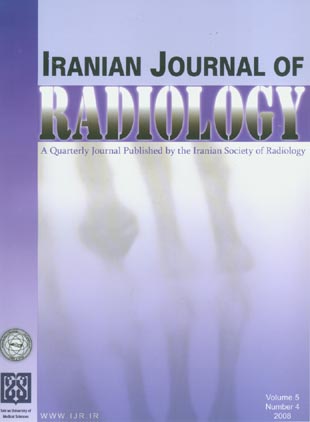فهرست مطالب

Iranian Journal of Radiology
Volume:5 Issue: 4, Summer 2008
- 74 صفحه،
- تاریخ انتشار: 1387/11/01
- تعداد عناوین: 12
-
-
Page 189Congenital intestinal lymphangiectasia is a rare protein-losing enteropathy that usually affectschildren and young adults. Major symptoms include peripheral edema, mild non-bloodydiarrhea, and chylous effusions that may develop during the course of the disease.In this disorder intestinal lymphatic vessels show fibrous occlusions that lead to pressureelevation of the lymphatic flow and rupture of the small lymphatic vessels. Transudation oflymph fluid into the different layers of the intestinal wall and lumen then occurs.
-
Page 195Mature teratomas are the most common type of mediastinal germ cell tumors. They typically occur in young adults (15 to 35 years) and 95% of these teratomas occur in the anterior mediastinum.Herein, we report a case of a huge mediastinal teratoma in a 16-year-old boy who presented with a history of chest pain, cough, exertional dyspnea, and fever. Chest X-ray and spiral computed tomography (CT) revealed a bulky mass of 20×15 cm in the right side of the posterior mediastinum. The operative finding was a large cystic mass in the posterior mediastinum adherent to the neighbor organs. The cyst was filled with sebum, hair and calcified materials.The resected tumor was in the posterior mediastinum, although most of these tumors occur in the anterior mediastinum. To the best of our knowledge, this is the first documented report in Iran.
-
Page 199Pneumoscrotum is a rare condition that occurs following a variety of procedural and pathologicalcauses. We report a case of multiple trauma, pneumothorax and surgical emphysema,who presented with a swollen scrotum.
-
Page 205Presented here is a 47-year-old man for whom right central venous chemoport catheterizationwas performed without radiological guidance. Within 8 days, the catheter became nonfunctionaland non-contrasted thoracic CT was performed to trace its course. The tip of thecatheter appeared to have perforated the opposite wall of the ipsilateral brachiocephalic veinand entered the adjacent brachiocephalic artery. It then maintained its course along the ascendingaorta to perforate, once again, the opposite wall of the aorta before finally resting inthe aortopulmonary soft tissue. Migration of chemoport is not uncommon, and may presentin many ways. However, it is rare for a migration to occur in the way described here andonly present with catheter blockage. Radiological guidance of any central vascular catheterizationgreatly reduces the risk of complications.
-
Page 209Foreign body in the esophagus is a common emergency presentation. Conventional x-ray imaging is usually obtained to aid the diagnosis during the initialevaluation. The decision for surgical intervention is usually based on a suspicious history,physical examination and radiologic findings. Our hypothesis is that radiographic imagingshould not alter the decision for surgical intervention in patients with a suspicious historyand appropriate findings on physical examination.
-
Page 215The problem of localization of speech associated cortices using noninvasive methods has been of utmost importance in many neuroimaging studies, but the resultsare difficult to resolve for specific neurosurgical applications. In this study, we used fMRIto delineate language-related brain activation patterns with emphasis on the Broca’s areaduring the execution of two Persian language tasks.
-
Page 221Tuberous sclerosis is an autosomal dominant genetic disease that involves multiple organs.Hamartomas are the predominant lesions. Classically, tuberous sclerosis has been characterizedby a classical clinical triad of facial angiofibromas (90%), mental retardation (50-80%),seizure (80-90%) and all three in 30% of the patients. Two major features or one major featureplus two minor features are necessary for the definite diagnosis of this disease. We hadsome patients admitted with different presentations of tuberous sclerosis and a past historyof convulsion from childhood, skin lesions and also mental retardation with a new onsetheadache and a changed pattern of convulsion. In physical examination, facial angiofibromasand subungual fibromas were apparently detected. Brain CT scan study with contrastshowed multiple calcified nodules associated with tubers, ventriculomegaly and also enhancingenlarged nodules at the foramen of Monro, which were suggestive of subependymal giantcell astrocytoma (SGCA). MRI showed the same brain findings (tubers, white matter lesionsand subependymal nodules associated with SGCA), which were detected better. After surgery,SGCA was proved. In abdominal and pelvic CT scan and ultrasonography, massive bilateralangiomyolipomatosis and focal hypodense hyperechoic liver lesions were detected.
-
Page 231Pulmonary tuberculosis (TB) is a common worldwide lung infection. It remains an important cause of morbidity and mortality. Radiographic manifestations ofpulmonary tuberculosis are diverse and varied. This study was performed to define the variousradiographic manifestations of this infection in the pediatric age group in children whowere referred to Mofid Children’s Hospital.
-
Pages 245-246


